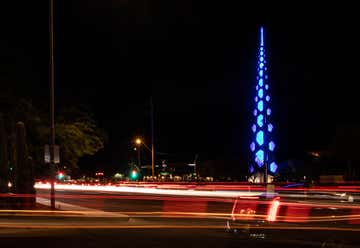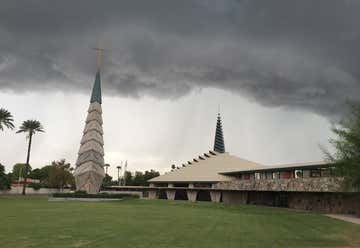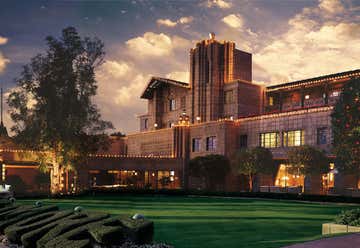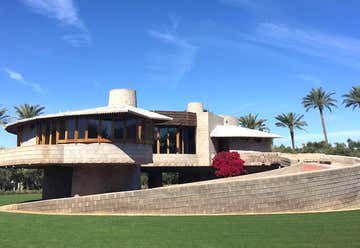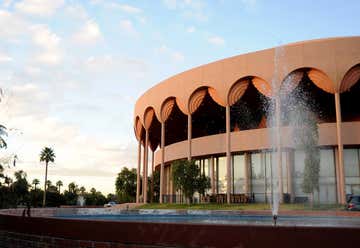Frank Lloyd Wright is one of the most influential architects in modern history, drawing heavily on inspiration from nature. Although he began his career in the Midwest, he felt drawn to the dramatic desert landscapes of Arizona, saying "Arizona needs its own architecture… long, low, sweeping lines, uptilting planes. Surface patterned after such abstraction in line and color as find 'realism' in the patterns of the rattlesnake, the Gila monster, the chameleon, and the saguaro, cholla or staghorn – or is it the other way around—are inspiration enough." His winter home, Taliesin West, was where he dreamed up some of the most distinctive and stunning buildings, and taught students his unique style. Here's a guide to the Frank Lloyd Wright gems across Phoenix!
Start your FLW tour at Taliesin West, the architect's winter home from the late 1930s until his death in the late 1950s. Today, it's the home of the Frank Lloyd Wright School of Architecture, and it's open for tours. The hour-long Panorama Tour shows off the highlights of the building, which is a perfect example of Wright's ability to blend indoor and outdoor spaces. The 90-minute Insights Tour gets you behind the scenes into more of Wright's private quarters, and the Garden Tour and the Night Lights Tour are extra-special offerings that are also worth looking into.
The Frank Lloyd Wright Spire-- on Frank Lloyd Wright Boulevard in Scottsdale-- is an interesting little gem. Wright designed it for the Arizona State Capitol in the mid-1950s, but it was ultimately rejected. Then in 2004, Scottsdale decided to create and erect the spire in Wright’s honor. The blue-and-green hued spire lights up at night, so it's worth checking out during the day and after the sun sets.
Another Frank Lloyd Wright-designed building that didn't actually come to fruition until after his death is the First Christian Church in Phoenix. FLW was commissioned to design an entire campus for the Southwest Christian Seminary, but the school closed down before construction could begin. In the 1970s, his widow granted the First Christian Church permission to use the design of the chapel for their new place of worship. The church, and the freestanding bell tower topped with a 22-foot cross, both appear to be triangular, but in actuality have 4 sides. Cruise past to check it out!
Although Frank Lloyd Wright wasn't the main architect of the opulent Arizona Biltmore, A Waldorf Astoria Resort, he consulted on the project with main designer Albert Chase McArthur, and Wright's influence is incredibly apparent, especially in the lobby. The hotel was built in the late 1920s and has been the definition of luxury for Phoenix resorts ever since.
Additional nods to Wright have been added in after the fact as well: Look for the stained glass windows, named "Saguaro Forms and Cactus Flowers”. The design was originally created by Wright for a magazine cover, and Taliesin students crafted the glass windows, which were installed during a renovation in the 1970s.
Frank Lloyd Wright designed the David & Gladys Wright House in the 1950s as a private residence for his son and daughter-in-law. Located at the base of Camelback Mountain in a citrus grove, the building's design is especially unique. The long, curved ramp up to the home foreshadows the design of the Guggenheim, which Wright would craft seven years later, and the David and Gladys Wright House's circular design was intended to capture the breezes to cool the home off naturally.
The Wright House is currently closed for tours, but it is expected to reopen in the future. Contact them for details.
Frank Lloyd Wright's last public work was Arizona State University's Grady Gammage Auditorium. Based on an earlier design for an opera house in Baghdad, Iraq, that never panned out, the circular, almost seashell-like building is done in terra cotta tones that echo the surrounding desert. Unfortunately, Wright and Grady Gammage, the ASU president who commissioned the auditorium, both died before its completion, but Wright's trusted aide, William Wesley Peters, brought FLW's design to life.
Bonus: Frank Lloyd Wright's influence reaches beyond the buildings he himself designed. His students went on to create great architectural gems themselves, like the Hotel Valley Ho. Designed by FLW's protégé Edward L. Varney, the Valley Ho's design is distinctly jet-age futuristic. One of the first hotels in Scottsdale with air conditioning and a parking lot next to the rooms, it was the height of style in the late 1950s and early 1960s-- Natalie Wood, Bette Davis, Roy Rogers, Bing Crosby, Humphrey Bogart, Marilyn Monroe, Zsa Zsa Gabor, and Cary Grant were among the celebs who stayed here. In the 70s, many of the retro details were removed, as they were seen as outdated, but a 2002 renovation restored a lot of the original mid-century modern flavor.
Tons of organic touches were brought back to life during the renovation as well. Southwestern columns, stone walls and floors, redwood ceilings, and tons of glass echo Wright's signature style. The hotel offers 90-minute architectural tours of the property that delve into the hotel's storied past and unique design.
As one of America's most ingenious and prolific architects, Frank Lloyd Wright changed architecture and design as Americans knew it... multiple times! Phoenix's unique landscapes inspired some of Wright's most stunning and singular pieces. Studying his designs here will likely inspire you to look at Phoenix in a new light, and find the beauty in the Sonoran Desert.


